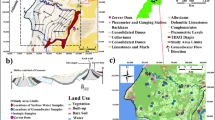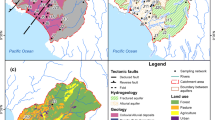Abstract
Aquifer-based groundwater quality assessment offers critical insight into the major hydrochemical processes, and aids in making groundwater resources management decisions. The Texas Rolling Plains (TRP), spanning over 22 counties, is a major agro-ecological region in Texas from where highest groundwater nitrate (NO3 −) levels in the state have been reported. In this study, we present a comparative assessment of major hydrochemical facies pertaining to NO3 − contamination and a host of species such as sulfate (SO4 2−), chloride (Cl−), and total dissolved solids (TDS) in different water use classes in the Seymour and Blaine aquifers, underlying the TRP. Aquifer-stratified groundwater quality information from 1990 to 2010 was obtained from the Texas Water Development Board and aggregated over decadal scale. High groundwater salinization was found in the municipal water use class in the Blaine aquifer with about 100, 87 and 50 % of observations exceeding the secondary maximum contaminant level for TDS, SO4 2−, and Cl−, respectively in the 2000s (2000–2010). The NO3-contamination was more alarming in the Seymour aquifer with 82 and 61 % of observations, respectively, exceeding the maximum contaminant level (MCL) in the irrigation and municipal water use classes in the 2000s. Salinization was more influenced by SO4 2− and Cl− in the Blaine aquifer and by NO3 − in the Seymour aquifer. High NO3 − (>MCL) observations in the Seymour aquifer occurred in the Ca–HCO3 and Ca–Mg–HCO3 facies, the domains of fresh water recharge and anthropogenic influences (e.g., agricultural activities, waste disposal). High SO4 2−, Cl− and TDS observations in the Blaine aquifer dominated the Ca–Cl, Na–Cl, and mixed Ca(Mg)–SO4(Cl) facies indicating evaporite dissolution, mixing and solute exchange, and lack of fresh recharge.






Similar content being viewed by others
Abbreviations
- ESRI:
-
Environmental systems research institute
- MCL:
-
Maximum contamination level
- SI:
-
Saturation index
- SAS:
-
Statistical analysis system
- SMCL:
-
Secondary maximum contaminant level
- TRP:
-
Texas Rolling Plains
- TWDB:
-
Texas Water Development Board
- TDS:
-
Total dissolved solids
- USDA:
-
United Stated Department of Agriculture
- US EPA:
-
United States Environmental Protection Agency
- USGS:
-
United State Geological Survey
- WIID:
-
Water Information Integration and Dissemination
References
Alderman JH, Hudak PF, Acevedo M (2003) Chemical ratios and groundwater contamination in east Texas. Bull Environ Contam Toxicol 96:793–799
Anudu GK, Obrike SE, Onuba LN, Ikpokonte AE (2011) Hydrogeochemical analysis and evaluation of water quality in Angwan Jeba and its environs, Nasarawa State, north central Nigeria. Res J Appl Sci 6:128–135
Ashworth JB, Hopkins J (1995) Major and minor aquifers of Texas. Texas Water Development Board Report, 345, p 66
Bartolino JR, Cunningham WL (2003) Ground-water depletion across the nation. US Geological Survey, Fact Sheet 103-03, p 4
Bradley RG, Petrini H (1998) Priority groundwater management area update on area 16, Rolling Prairies region of north central Texas. Texas Water Development Board, Open File Report 98-03B, p 21
Chaudhuri S, Ale S (2013) Evaluation of groundwater resources in the Trinity–Woodbine aquifer system, north-central Texas. Sci Total Environ 452–453:333–348
Chaudhuri S, Ale S, Delaune P, Rajan N (2012) Spatio-temporal variability of groundwater nitrate concentration in Texas: 1960–2010. J Environ Qual 41:1806–1817
DeSimone LA (2009) Quality of water from domestic wells in principal aquifers of the United States, 1991–2004. US Geological Survey Scientific Investigations Report, 2008–5227
DeSimone LA, Hamilton PA, Gilliom RJ (2009) Quality of wells from domestic wells in principal aquifers of United State. US Geological Survey, Circular 1325, p 58
Duffin G, Beynon B (1992) Evaluation of water resources in parts of the Rolling Plains region of north-central Texas. Texas Water Development Board, Report No. 337, p 93
Dutton AR (1989) Hydrogeochemical processes involved in salt-dissolution zones, Texas Panhandle, USA. Hydrol Process 3:75–89
Dutton AR (1995) Groundwater isotopic evidence for paleorecharge in the US High Plains aquifers. Quat Res 43:221–231
Dutton AR (2005) Analysis of selected groundwater quality trends in the Panhandle Water Planning Area. Freese and Nicholas Inc. and Panhandle Water Planning Group, p 64
El-Ficky AA (2006) Hydrochemical characteristics and evolution of groundwater at the Ras Sudr-Abu Zenima area, southerst Sinai, Egypt. Earth Sci 21(1):79–109
EPA (2009) Edition of the drinking water standards and health advisories. Environmental Protection Agency, Report 822-R-09-011, p 18
Ewing JE, Jones TL, Pickens JF (2004) Groundwater availability model for the Seymour aquifer. Texas Water Development Board, Report, p 533
George PG, Mace RE, Petrossian R (2011) Aquifers of Texas. Texas Water Development Board, Report 380, p 182
Gibbs RJ (1970) Mechanisms controlling world water chemistry. Science 170:1088–1090
Harden RW et al. (1978) The Seymour aquifer, ground-water quality and availability in Haskell and Knox Counties, Texas. Texas Water Development Board Report 226
Hopkins J, Muller C (2011) Water quality in the Blaine aquifer. Texas Water Development Board Report 376, p 48
Hudak PF (2000a) Regional trends in nitrate content of Texas groundwater. J Hydrol 228:37–47
Hudak PF (2000b) Sulfate and chloride concentrations in Texas aquifers. Environ Int 26:55–61
Hudak PF (2001) Water hardness and sodium trends in Texas aquifers. Environ Monit Assess 68:177–185
Jeevanandam M, Kannan R, Srinivasalu S, Rammohan V (2007) Hydrogeochemistry and groundwater quality assessment of lower part of the Ponnaiyar River Basin, Cuddalore district, South India. Environ Monit Assess 132:263–274
Jeevanandam M, Nagarajan R, Manikandam M, Snthilkumar M, Srinivasulu S, Prasanna MV (2012) Hydrogeochemistry and microbial contamination of groundwater from the lower Ponnaiyar Basin, Cuddalore District, Tamil Nadu, India. Environ Earth Sci. doi:10.1007/s12665-012-1534-1
Johnson KS (1985) Structure contour map and stratigraphic/hydrologic data on the Blaine aquifer in the Hollis Basin of southwestern Oklahoma. Oklahoma Geological Survey Open-File Report. Scale 1:125,000
Kilham P (1990) Mechanisms controlling the chemical composition of lakes and rivers: data from Africa. Limnol Oceanogr 35(1):80–83
Krishnaraj S, Murugesan V, Vijayaraghavan K, Sabarathium C, Paluchamy A, Ramachandran M (2011) Use of hydrogeochemistry and stable isotopes as tools for groundwater evolution and contamination investigations. Geosciences 1:16–25
Kumar M, Kumari K, Ramanathan AL, Saxena R (2007) A comparative evaluation of groundwater suitability for irrigation and drinking purposes in two intensively cultivated districts of Punjab, India. Environ Geol 53:553–574
Kumar SK, Rammohan V, Sahayam JD, Jeevanandam M (2009) Assessment of groundwater quality and hydrogeochemistry of Manimuktha River basin, Tamil Nadu, India. Environ Monit Assess 159:341–351
Maderak ML (1972) Ground-water resources of Hardeman County, Texas. Texas Water Dev Board Rep 161:45
Nur A, Isaku JM, Taiyib A (2012) Spatial distribution of chemical facies using geographical information system (GIS) in Michika, northeastern Algeria. Res J Eng Appl Sci 1(2):102–109
ODNR (2011) Ground water quality. Division of Soil and Water Resources, Fact Sheet 97-47
Olobaniyi SB, Owoyemi FB (2006) Characterization by factor analysis of the chemical facies of groundwater in the deltaic plain sands aquifer of Warri, western Nigeria Delta, Nigeria. Afr J Sci Technol 7(1):73–81
Ophori DU, Toth J (1989) Patterns of ground-water chemistry, Rock Creek Basin, Alberta, Canada. Ground Water 27(1):20–26
Piper AM (1944) A graphical procedure in the geochemical interpretation of water analysis. Am Geophy Union Trans 25:914–923
Rajamohan N, Elango L (2003) Identification and evolution of hydrogeochemical processes in the groundwater environment in an area of the Palar and Cheyyar river basins, southern India. Environ Geol 46:47–61
Rout S (2011) A multivariate statistical model of geochemical factors of soils, sediments and groundwater. MS thesis, Bhabha Atomic Research Centre, Mumbai, India
Runkle DL, McLean JS (1995) Steady-state simulation of groundwater flow in the Blaine aquifer, southwestern Oklahoma and northwestern Texas. US Geological Survey, Open File Report, 94-387, p 96
Runkle DL, Bergman DL, Fabian RS (1997) Hydrologic data for the Blaine aquifer and associated units southwestern Oklahoma and northwestern Texas. US Geological Survey Open File Report 97-50, 200p
Scanlon B, Reedy R, Keese K (2003) Estimation of groundwater recharge in Texas related to aquifer vulnerability contamination. Bureau of Economic Geology, Technical Report, University of Texas at Austin
Schoeller H (1967) Geochemistry of Groundwater—an international guide for research and practice, UNESCO, pp 1–1.8
Smyth RC, Hovorka SD, Lu J, Romanak KD, Partin JW, Wong C (2008) Assessing risk to fresh water resources from long term CO2 injection-laboratory and field studies: presented at the 9th International Conference on Greenhouse Gas Control Technologies (GHGT-9), Washington, D.C. GCCC Digital Publication Series #08-03j
TWDB (2012) Water for Texas. Texas Water Development Board Report, Austin, TX
USEPA (2009) Edition of the drinking water standards and health advisories. Environmental Protection Agency, Report 822-R-09-011, p 18
USDA (2007) Technical guide to managing groundwater resources. US Department of Agriculture, Report FS-881, p 295
WHO (2006) Guidelines for drinking water quality. 3rd Edn, vol 1. p 595
Yamakanamardi SV, Hampannavar US, Purandara BK (2011) Assessment of chloride concentration in groundwater: a case study for Belgaum City. Int J Environ Sci 2:271–280
Zhang L, Song X, Xia J, Yuan R, Zhang Y, Liu X, Han D (2011) Major element chemistry of the Huai River basin, China. Appl Geochem 26:293–300
Acknowledgments
The funding for this research was provided by the Texas A&M AgriLife Research. We thank the Texas Water Development Board for providing the groundwater quality data.
Author information
Authors and Affiliations
Corresponding author
Rights and permissions
About this article
Cite this article
Chaudhuri, S., Ale, S. An appraisal of groundwater quality in Seymour and Blaine aquifers in a major agro-ecological region in Texas, USA. Environ Earth Sci 71, 2765–2777 (2014). https://doi.org/10.1007/s12665-013-2655-x
Received:
Accepted:
Published:
Issue Date:
DOI: https://doi.org/10.1007/s12665-013-2655-x




